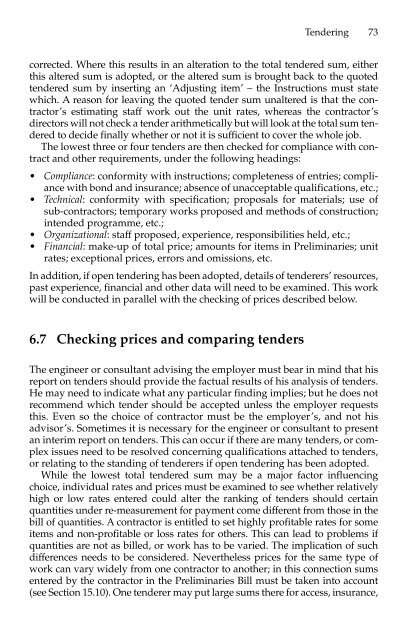Civil Engineering Project Management (4th Edition)
You also want an ePaper? Increase the reach of your titles
YUMPU automatically turns print PDFs into web optimized ePapers that Google loves.
corrected. Where this results in an alteration to the total tendered sum, either<br />
this altered sum is adopted, or the altered sum is brought back to the quoted<br />
tendered sum by inserting an ‘Adjusting item’ – the Instructions must state<br />
which. A reason for leaving the quoted tender sum unaltered is that the contractor’s<br />
estimating staff work out the unit rates, whereas the contractor’s<br />
directors will not check a tender arithmetically but will look at the total sum tendered<br />
to decide finally whether or not it is sufficient to cover the whole job.<br />
The lowest three or four tenders are then checked for compliance with contract<br />
and other requirements, under the following headings:<br />
• Compliance: conformity with instructions; completeness of entries; compliance<br />
with bond and insurance; absence of unacceptable qualifications, etc.;<br />
• Technical: conformity with specification; proposals for materials; use of<br />
sub-contractors; temporary works proposed and methods of construction;<br />
intended programme, etc.;<br />
• Organizational: staff proposed, experience, responsibilities held, etc.;<br />
• Financial: make-up of total price; amounts for items in Preliminaries; unit<br />
rates; exceptional prices, errors and omissions, etc.<br />
In addition, if open tendering has been adopted, details of tenderers’ resources,<br />
past experience, financial and other data will need to be examined. This work<br />
will be conducted in parallel with the checking of prices described below.<br />
6.7 Checking prices and comparing tenders<br />
Tendering 73<br />
The engineer or consultant advising the employer must bear in mind that his<br />
report on tenders should provide the factual results of his analysis of tenders.<br />
He may need to indicate what any particular finding implies; but he does not<br />
recommend which tender should be accepted unless the employer requests<br />
this. Even so the choice of contractor must be the employer’s, and not his<br />
advisor’s. Sometimes it is necessary for the engineer or consultant to present<br />
an interim report on tenders. This can occur if there are many tenders, or complex<br />
issues need to be resolved concerning qualifications attached to tenders,<br />
or relating to the standing of tenderers if open tendering has been adopted.<br />
While the lowest total tendered sum may be a major factor influencing<br />
choice, individual rates and prices must be examined to see whether relatively<br />
high or low rates entered could alter the ranking of tenders should certain<br />
quantities under re-measurement for payment come different from those in the<br />
bill of quantities. A contractor is entitled to set highly profitable rates for some<br />
items and non-profitable or loss rates for others. This can lead to problems if<br />
quantities are not as billed, or work has to be varied. The implication of such<br />
differences needs to be considered. Nevertheless prices for the same type of<br />
work can vary widely from one contractor to another; in this connection sums<br />
entered by the contractor in the Preliminaries Bill must be taken into account<br />
(see Section 15.10). One tenderer may put large sums there for access, insurance,


















